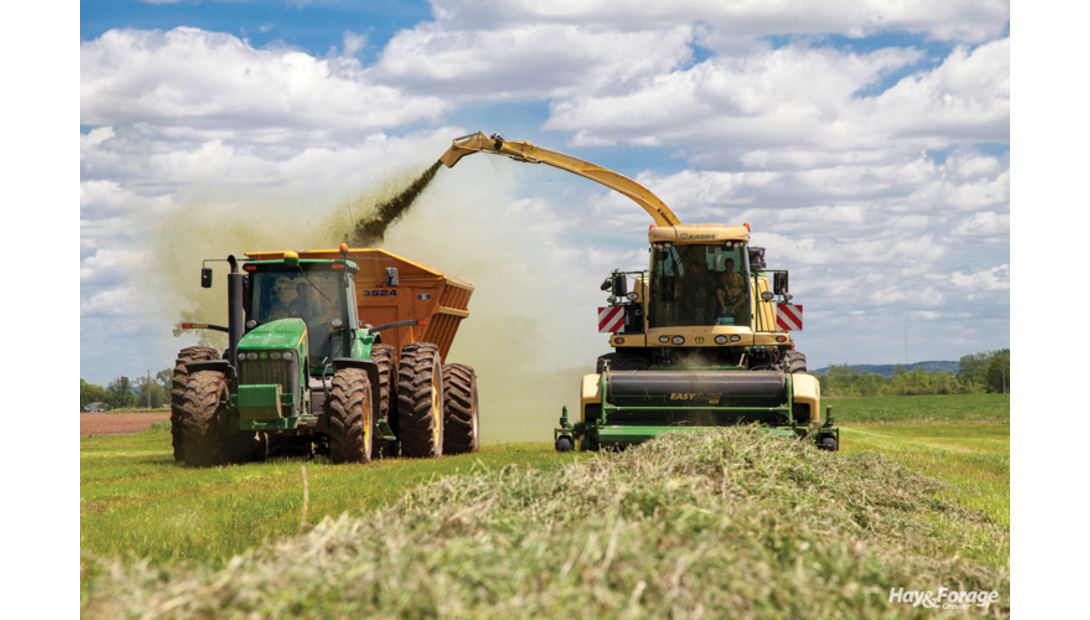The author is a forage professor emeritus with the University of Wisconsin-Madison.

Growing concern has been that many farmers lose too many leaves during the harvesting process. Leaf percentage of harvested alfalfa affects both yield and forage quality. This is illustrated from samples taken by students in the Winfield intern program shown in Table 1. The alfalfa was cut at a 3-inch height prior to mowing and then hand separated into leaves and stems. All fields were harvested for haylage. The interns also sampled the harvested forage and hand separated it into plant components.
On average, the leaf content was 8.9% less in the harvested forage than the standing alfalfa. With hay at $207 per ton (University of Wisconsin Midwest Hay Market Report, June 11, 2024), this represents a yield loss of $36.85 per acre for a 2 tons per acre yield, a forage quality loss of $102.35 per acre, and crude protein loss (with soybean meal at $365 per ton) of $4.23 per acre. The total loss then sums to $143.43 per acre for the 2 tons per acre dry matter yield. Some fields showed leaf losses approaching 20%!

Leaf loss measured
Leaf loss can occur prior to harvest due to disease or insects and based on the method of harvest. To help farmers better assess their alfalfa production and success in holding leaves, a near infrared spectroscopy (NIRS) equation for leaf percentage was developed by Forage Genetics International. NIRS is able to predict leaf content due to the different composition of leaves and stems. Figure 1 shows that NIRS is able to predict leaf content with 84% accuracy.
How are we doing?
The NIRS equation was licensed to forage testing laboratories and run on samples when the analysis was requested. The results to date from three laboratories offering the test are shown in Table 2.
Alfalfa is generally about 50% leaves at the bud stage. The means of all samples submitted ranged from 50.5% to 55.7%. This is higher than expected, but likely indicates that only better samples were submitted.

The standard deviation is the range that includes two-thirds of the samples. Considering that the standard deviation is about 10%, 16% of the samples were above 60% leaves and perhaps harvested too early with significant yield loss.
The test results can also encourage improved management for the 16% of samples below 40% leaves. Farmers harvesting these samples lost about $160 per acre with today’s prices and a 2 tons per acre yield.
Cut your losses
Farmers with significant leaf loss should evaluate and determine what can be done to improve leaf content. Some losses due to environmental effects are unavoidable; however, there are factors that can be managed:
- Diseases and insects can cause substantial leaf loss, so the use of fungicides and/or insecticides might be worthy of consideration.
- Moisture content of forage is important to leaf retention. This is why fields harvested as dry hay yield less than haylage (or baleage) fields.
- Drier forage at harvest also results in leaf loss, so some farmers harvest with dew present to keep more leaves. Farmers in more arid regions bale at night and/or use a steamer to artificially create dew.
- Equipment type, settings, and speed are important. Leaf loss is accelerated by use of a flail rather than roll conditioner, conditioning too aggressively, raking/merging too fast, or setting pickup speed faster than ground speed on the baler or chopper.
Knowing the leaf percentage of harvested alfalfa forage can aid in managing alfalfa production and harvesting to improve forage yield and quality. Consider having the test run on a few samples this year to help assess current harvest practices.
This article appeared in the July XL 2024 issue of Hay & Forage Grower on pages 28-29.
Not a subscriber? Click to get the print magazine.

